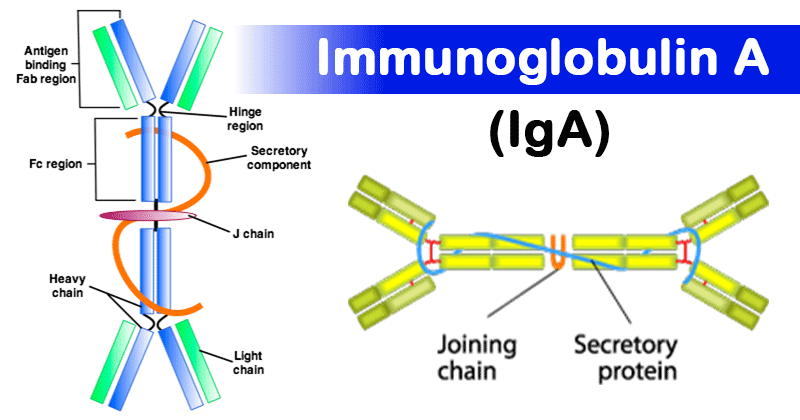- Antibodies, or ‘immunoglobulins’, are glycoproteins that bind antigens with high specificity and affinity.
- In humans there are five chemically and physically distinct classes of antibodies (IgG, IgA, IgM, IgD, IgE).
- Immunoglobulin A (IgA), is the major class of antibody present in the mucosal secretions of most mammals.
- It is the key first line of defence against invasion by inhaled and ingested pathogens at mucosal surfaces.

- It is present in mucous, tears, saliva, sweat, colostrum and secretions from the genitourinary tract, gastrointestinal tract, prostate and respiratory epithelium. It is also found in small amounts in blood.
- It comprises approximately 15% of the total serum immunoglobulin and thus is the second most common human immunoglobulin in serum with serum concentration of 1 to 4 mg/mL.
- In humans it is encoded by two genes within the immunoglobulin gene locus on chromosome 14. The 5′ IgA gene encodes IgA1 while 3′ IgA gene encodes IgA2.
Interesting Science Videos
IgA subclasses
- Two IgA subtypes exist in humans, IgA1 und IgA2.
- They differ in the molecular mass of the heavy chains and in their concentration in serum.
- IgA1 also differs from IgA2 in being susceptible to cleavage in its hinge region by proteases secreted by a number of different bacteria.
- In addition to that, IgA2 occurs in two allotypic forms, IgA2 (m1) and IgA2 (m2).
IgA1
– Predominant circulating IgA comprising approximately 85% of total IgA concentration in serum.
– IgA1 shows a good immune response to protein antigens and, to a lesser degree, polysaccharides and lipopolysaccharides.
IgA2
– IgA2, represents only up to 15% of total IgA in serum, but IgA2 percentages are higher in secretions.
– Plays a crucial role in the mucosa of the airways, eyes and the gastrointestinal tract to fight against polysaccharide and lipopolysaccaride antigens.
Structure of IgA
- Immunoglobulin A (IgA) is present in the serum as a 170 kDa, four polypeptide (two L and two H) chain protein.
- Its H-chain type is alpha (α).
- IgA exists in serum in both monomeric and dimeric forms.
- Although it exists primarily in monomeric form, followed by dimeric, trimeric and some tetrameric forms are also present.
- IgA in blood occurs in monomeric form whereas those in body secretion occur in dimeric or multimeric forms.
- In secretions, in addition to the κ or λ L-chains and the IgA heavy chain alpha, IgA also contains two other polypeptide chains – secretory component (SC) and J-chain (Joining chain).
- Secretory chains help in transcytosis of exocrine IgA and stabilize IgA against proteolytic degradation.
- The two four-chain units are held together by the J-chain through disulfide bridges.
Functions of IgA
- It primarily protects mucous membranes as IgA can cross the epithelial layer and enter into body secretion providing local immunity.
- Secretory IgA provides the primary defense mechanism against some local infections because of its abundance in mucosal secretions (e.g., saliva and tears).
- It prevents the passage of foreign substances into the circulatory system.
- In body secretion IgA neutralize viruses and prevent attachment on host surface.
- IgA is resistant to digestion and although a poor activator, can activate the complement pathway when aggregated.
- Secretory IgA can also inhibit inflammatory effects of other immunoglobulins.
References
- https://www.thermofisher.com/kr/en/home/life-science/antibodies/antibodies-learning-center/antibodies-resource-library/antibody-methods/immunoglobulin-iga-class.html
- https://www.bio-rad-antibodies.com/iga-immunoglobulin-a-antibody.html
- https://www.ncbi.nlm.nih.gov/pmc/articles/PMC1782559/
- Lydyard, P.M., Whelan,A.,& Fanger,M.W. (2005).Immunology (2 ed.).London: BIOS Scientific Publishers.
- Playfair, J., & Chain, B. (2001). Immunology at a Glance. London: Blackwell Publishing
